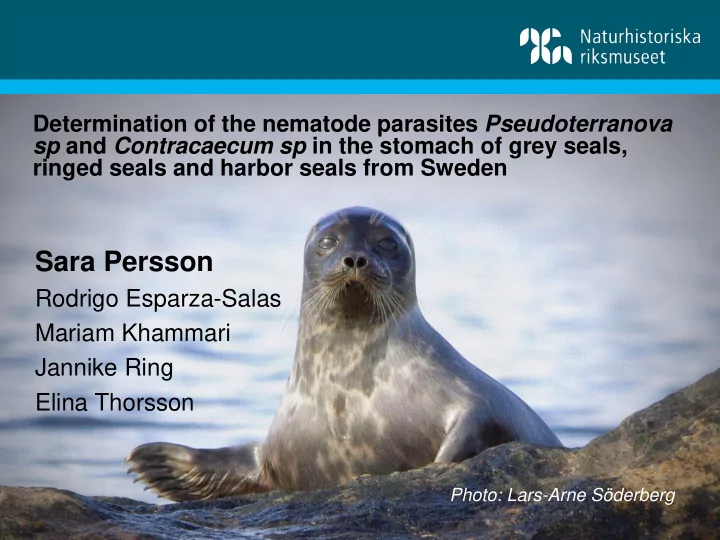

Determination of the nematode parasites Pseudoterranova sp and Contracaecum sp in the stomach of grey seals, ringed seals and harbor seals from Sweden Sara Persson Rodrigo Esparza-Salas Mariam Khammari Jannike Ring Elina Thorsson Photo: Lars-Arne Söderberg
Background • Baltic cod – Fewer – Smaller – Low body condition – Parasites • Causes? • Fishing • Increasing population of seal – increasing amount of parasites in cod? • Knowledge about how the parasites vary in the seal is lacking
Cod/seal parasites • Pseudoterranova decipiens in cod muscle – ” Cod worm ” or ” seal worm ” • Contracaecum osculatum in cod liver – ”Liver worm ” • Seals are main host • Life cycle with many intermediate fish hosts
Materials and methods • 41 ringed seals 2015-2017 • 60 grey seals 2017-2018 • 55 harbour seals 2017-2018 • Parasites were weighed (if all nematodes could be collected) and stored in 75% alcohol • Stomach fluid from necropsied seals was preserved in buffer for DNA analysis • Parasite lesions were noted
Results: prevalence, weight • Cod worm and liver worm look identical macroscopically • Ringed seal: 4.7% – only 1-2 worms • Grey seals: 100% – Mean 20.5 gram – 4-95 gram • Harbour seals: 98% – Mean 1.8 gram – 0.2-13 gram
Stomach lesions in the seals Ringed seal 0% Grey seal 65% Harbour seal 64%
Variation in larvae stages • Adult parasites (L5) reproduce and produce eggs • Large variation in larvae size within the seal • Proportion of nematodes of the larger type varied a lot in both GS and HS (0 - 100 %) • Weighing parasites does not say much about capacity to spread eggs (and can be very time consuming)
Why the large variation in the amount of adult nematodes? • Snap shot • Differences in defense of the seal host • Differences in fitness of the parasites (in earlier life stages) • P.decipiens fecundity (egg production) will be affected by the seal – immune system, – age, – diet – how many parasites that the seal is continuously infected by (McClelland, 2002, Johansen et al., 2010).
DNA analysis of stomach fluid • A new set of DNA barcode markers was designed to target a short fragment of the mitochondrial LSU gene of parasitic worms of the family Anisakidae. • The LSU fragment was amplified in DNA extracts from 114 seal stomach samples • LSU was amplified from DNA abstracts from the ethanol used to preserve the nematodes (N=12) • The sequence output data was de-multiplexed, filtered and identified to species by comparing to a custom- made reference sequence database of LSU genes of Anisakidae • 59 of the studied samples amplified the LSU fragment successfully – Inhibiting substances, degraded DNA
Results Proportion of nematode species in stomachs from seals collected from different areas (mean and range) Unidentified Anisakidae, Bothnian Contracaecum P. decipiens Ascaridida och bay N osculatum sensu lato Chromadorea Ringed seal 1 99% 0.002% 0.002% Grey seal 3 100% (99.99-100) 0.003% (0-0.008) 0.004% (0-0.01) Bothnian sea Grey seal 11 99.6 % (97.5-100) 0.2% (0.001-2.5) 0.1% (0.001-0.05) Baltic proper Grey seal 22 97.1% (38.6-100) 2.9% (0-61.4) 0.003% (0-0.013) Harbour seal 2 0.07% (0.005-0.02) 93.9% (87.9-99.9) 6.1% (0-12.1) Skagerack+ Kattegatt Harbour seal 20 7.7 % (0-94.4) 88.0% (1.9-100) 2.5% (0-23.3)
Conclusions • Parasite lesions in the gastric wall are common but most often mild (GS and HS) • Pattern: – grey seals are most often infected by Contracaecum spp only – harbour seals are most often infected by Pseudoterranova spp only The DNA barcoding provide a time-efficient method for the identification of nematode parasites that would be otherwise impractical to carry out in large-scale monitoring
Further studies • Score/classification of parasite load • Score/classification of number of large nematodes (~fecundity) • DNA analysis of species and species proportion within each seal • Adding more data • Geographical study (ideas?) • Harbour seals from the Baltic proper interesting • Variation with, age, sex. Health.
Recommend
More recommend